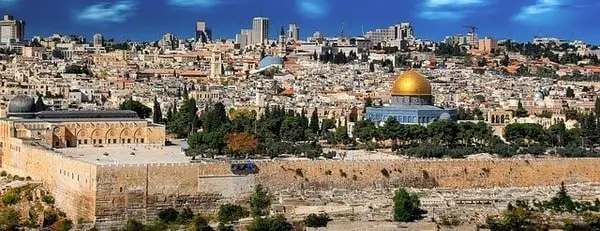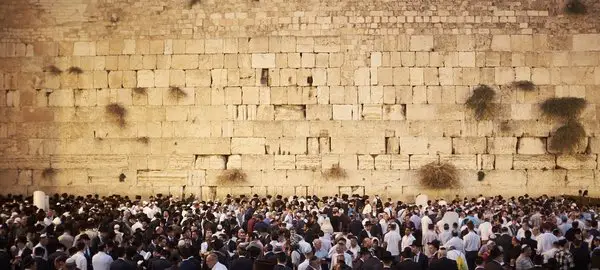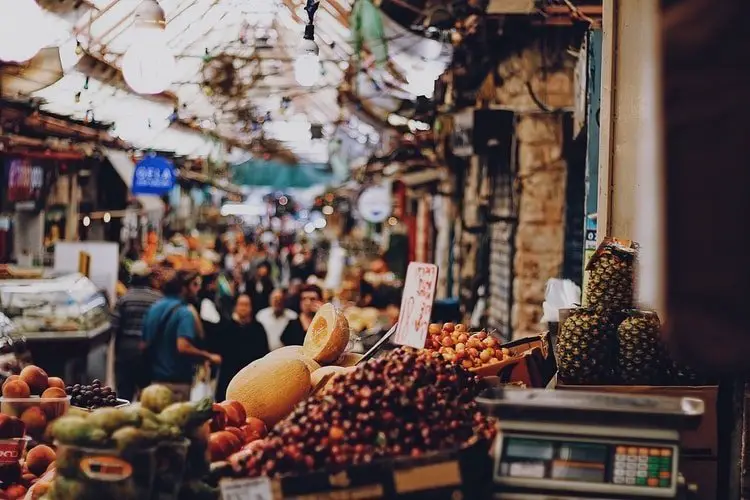If it weren’t for the scorching temperatures and unfamiliar alphabet on the menus, Tel Aviv could have been any cosmopolitan European city. Bauhaus buildings, cool cafés and a beach stretching for miles give the city its distinct character, enhanced by the fading grandeur of the architecture, the unapologetic bustle of its inhabitants – and their beauty.

After two days of city strolls, sunning myself and fine dining in Tel Aviv, my travel companion (and unofficial guide through my Israeli experience) Daniel and I boarded the bus to Jerusalem.
I say ‘boarded’ so casually, as though we just breezed up to the bus stop and clambered on board, but the reality was rather different. Queuing for the penultimate bus to depart before the Sabbath shutdown which descends across the public transport network each Friday afternoon, we were jostled, trodden on and engulfed in a mêlée of travelers desperate to reach Jerusalem.
No orderly English lines here: It was every man, woman or child for themselves, so I put my elbows to use and joined the fray.
Arriving in Jerusalem, I could instantly sense the difference from secular Tel Aviv: Far more religious observers mingled with trendily dressed teenagers on the streets, and the atmosphere seemed more reserved. But I would have to wait until the following afternoon to explore; it was time for my first Shabbat dinner, enjoyed with Daniel’s friends who live in Jerusalem.
On Saturday afternoon, we began our wanderings around the Old City at the Jaffa Gate, one of a number of grand entrances to Jerusalem’s walled historical quarter, site of so many important monuments and the scene of so many historical events. Walking past the Tower of David, we entered the Armenian Quarter (one of the four neighborhoods which make up the traffic-free Old City), its streets calm with the quiet of the Sabbath.

Along with the faithful, we made our way towards the Western (sometimes referred to as Wailing) Wall, pausing to take in a spectacular view of the Temple Mount, dominated by the golden gleam of the Dome of the Rock, with the Mount of Olives (a possible site of the resurrection and an important Jewish burial ground) providing a backdrop.
Passing through the security check into the Western Wall plaza, the atmosphere suddenly became more spiritual, quieter still. Covering my shoulders to please the ‘modesty police,” I sat back and watched the men and women at prayer, each in their separate areas, reaching forward to touch the Wall – the holiest site in the Jewish tradition.
Upon exiting at the other side of the plaza, we were suddenly plunged into the Muslim Quarter; a vibrant area of stalls and shops, their owners enticing us in to browse their selections of spices, trinkets, and tourist tat. The murmured language around us shifted from Hebrew to Arabic and I struggled to tune in, seeing if I could put my year’s worth of Arabic classes to good use. Click here to read about proper Muslim etiquette.
Passing by a bar, we heard the unmistakable cheer of sports fans and popped our heads around the door to check the score of the World Cup quarter-final, Germany versus Argentina. A friendly patron informed us that Germany was winning and invited us in. A bit of a football fan, I made my way inside to find more than fifty curious male faces turned towards me.
I was initially a little daunted to be the only woman in the bar, but even my gender couldn’t compete with football for long – after plenty of smiles, a few questions and the offer of a seat, all eyes returned to the screen. Sipping a bargain limonana (lemonade with crushed ice and mint, a delicious way to combat the Israeli heat), we watched through the haze of smoke as Germany crushed their rivals, understanding barely a word of the Arabic commentary.
Once the match was over, we wandered down a section of the Via Dolorosa, the road that Jesus is thought to have taken when he carried his cross to Calvary, passing several of the nine stations of the cross.
Our next stop was the haven of relaxation that is the Austrian Hospice, a Christian-run hotel, café, and cultural center. We took a seat in the peaceful garden positioned above the street, savoring an iced coffee, quietly watching the bustle in the street below and gazing beyond to the skyline, dotted with churches and mosques.
As the afternoon wore on and the sun descended over the rooftops, the honey-colored buildings of the Old City took on a warm glow. Climbing up to the roof of the Austrian Hospice, I was momentarily mesmerized by the panoramic view: the vista from the garden was captivating enough, but this was something else – the whole of Jerusalem was at our feet; a carpet of spires, satellite dishes, towers, and tangled streets.***

As the sun set, we made our way back to the Wall to watch the prayers as Shabbat went out. Too slow to adjust my scarf this time, I unwittingly revealed my arms to an orthodox rabbi. Once I was safely covered, we sat in the square and watched the hive of spiritual activity around us: the faithful dressed in their finest, bustling to and fro; groups of men praying and singing; the women more solitary.
As darkness descended, the Sabbath was deemed to have ended and candles were lit. The worshipers departed for the ‘new city’ and so did we, reflecting on the events of our afternoon in Jerusalem.
JERUSALEM | THE OLD CITY
Header Photo by Roxanne Desgagnés
